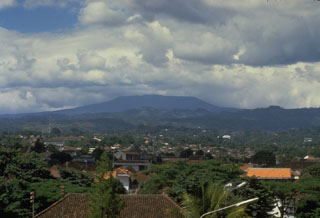Report on Tangkuban Parahu (Indonesia) — January 1986
Scientific Event Alert Network Bulletin, vol. 11, no. 1 (January 1986)
Managing Editor: Lindsay McClelland.
Tangkuban Parahu (Indonesia) Decreasing fumarole temperatures
Please cite this report as:
Global Volcanism Program, 1986. Report on Tangkuban Parahu (Indonesia) (McClelland, L., ed.). Scientific Event Alert Network Bulletin, 11:1. Smithsonian Institution. https://doi.org/10.5479/si.GVP.SEAN198601-263090
Tangkuban Parahu
Indonesia
6.77°S, 107.6°E; summit elev. 2084 m
All times are local (unless otherwise noted)
"In November [1985], Tangkubanparahu showed increased activity with strong gas emission, thick white solfataric fume, and increased temperature at Kawah Baru, a small vent on the W side of the summit crater (10:11-12). Temperatures, normally 95-97°C, rose to 141°C on 30 November, increased progressively to 173°C on 3 January, then slowly decreased. At the end of January the temperature was 158°C. Seismic observations Nov-Jan showed no signs of changes. The average number of volcanic earthquakes was 2/day."
Geological Summary. Gunung Tangkuban Parahu is a broad stratovolcano overlooking Indonesia's former capital city of Bandung. The volcano was constructed within the 6 x 8 km Pleistocene Sunda caldera, which formed about 190,000 years ago. The volcano's low profile is the subject of legends referring to the mountain of the "upturned boat." The Sunda caldera rim forms a prominent ridge on the western side; elsewhere the rim is largely buried by deposits of the current volcano. The dominantly small phreatic eruptions recorded since the 19th century have originated from several nested craters within an elliptical 1 x 1.5 km summit depression.
Information Contacts: A. Sudradjat, VSI.

